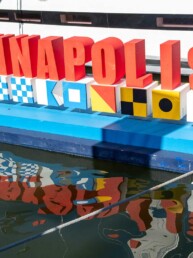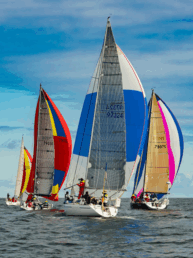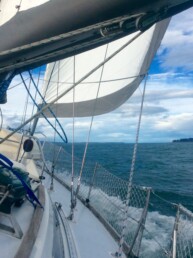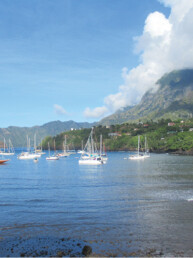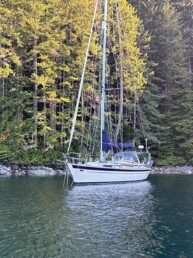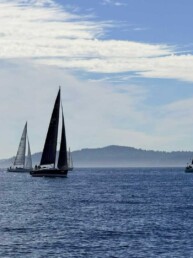
Spi Ouest is the largest annual regatta in France. This year, there were 405 boats and over 2,000 (mostly French) sailors. It is an amazing spectacle, with seven racing areas and lots of different classes. On our Jeanneau Sunfast 3300, Red Ruby, we raced in the IRC Double class, which consisted of 28 offshore capable boats of many designs from 26 to 41 feet. It is one of the most competitive regattas for doublehanded short coastal racing in France. The races usually start with a short upwind, then random legs from 1 to 9 miles around the rocky but beautiful Baie de Quiberon, resulting in 20 to 40 mile races with lots of corners. My doublehanded partner Alyosha Strum-Palerm and I raced this event on Red Ruby last year. We sailed well and learned a lot, but we were OCS in one race—in a no-drop series—so our result was not what we hoped for. This year we wanted to do better, which we did! But the result was still not what we wanted.
A program like Red Ruby Racing requires a lot of logistics and management of thousands of details large and small. It takes a village. In this case, we had to get the boat from Malta in the eastern Mediterranean, to La Trinité-sur-Mer in Brittany. We also made some modifications and upgrades to our boat during the winter. After boatyards, delivery crews, shipping companies, marinas, and port authorities, we arrived in La La Trinité-sur-Mer to find our trusty steed patiently waiting for us, tugging at her dock lines in the ever-present Breton current.
Alyosha and I had not raced together since July, so we were anxious to get on the water for sea trials and crew training. However, we arrived in Brittany in the midst of a series of lows and frontal passages, resulting in gale force winds for two of our three potential practice days. Not ideal, but nevertheless we felt pretty ready when race day dawned. With 20 to 30 knots forecast, we used the J3 headsail for the first upwind We had a decent start but got pinched off by a J/99. We tacked right, which turned out well and we rounded the first mark in the lead. “This is going really well!” we thought.
After a good Code Zero reach, we struggled a bit for pace in the next long upwind, but we nonetheless rounded third, with a run followed by a short reach to the finish. We had a good set but our first jibe went horribly awry, with the kite wrapped around the jib halyard and headstay around 50 times. We finally got it sorted out, but it cost us a couple minutes and at least three places, as we ended up sixth on corrected time. Not horrible, but a disappointment after sailing most of the race really well.
The next day was a little lighter, 16 to 22 knots, so we went with the bigger J2 jib. In race two, we had a good start but got rolled by a J/120, then struggled to find clean lanes for the rest of the upwind, rounding the top mark in tenth. We got right to work on the next 5-mile reach, using the Code Zero to pass six boats in our class. Then it was a long windy beat across a tricky current stream to a small island called La Vielle. Our tactics seemed ok but we got passed by some boats that went more south, so again it was catch up time! We had a little snag with the furler unit, but once we unrolled the big Code Zero we passed three boats again, and another on the next run. From there, it was two jib reaches to the finish at the harbor mouth. We held our position to cross the line in fourth, and corrected to fifth. Not bad. Hard fought.
Race three was an epic and dramatic one, with a frontal passage right during the start. The 15 to 20 knot easterly went south then finally west-southwest. Again, we started well at the favored end and were the first boat to set a flying sail as the leg broadened. We were second after a long reach, then third at the next island rounding as the bigger boats passed us upwind. A local JPK 1030 was gaining but we kept it close. We rounded just behind them with a 3-mile run to the finish, did a better set, and pulled even. But our asymmetrical kite was no match for their symmetrical spinnaker for the 15 knot run, and they ended up putting their time on us by the finish. We scored fourth, so with a 6,5,4 we were in fifth place with one race to go. Respectable.
The final race was both very cool and intensely frustrating, which sort of describes sailboat racing, doesn’t it? As with every other day, it was raining, cold, and squally on the sail out to the start. The forecast was 16 to 25 with higher gusts in the squalls, and it proved correct. But the wind was lightening and going left in the final minutes before our start, so we opted for the bigger J2. As the fleet set up towards the boat end, it became clear that the pin was favored and a port tack start was in play. We executed well, along with a JPK 1010, crossing the fleet easily and rounding the top mark with a good lead.
For the 5-mile reach to Mabahn Buoy, we quickly set and unfurled the Code Zero and took off. It turns out some of the other courses were also using our same course, so it was a crowded mess at the leeward mark, as scores of boats struggled to get kites down in the building breeze.
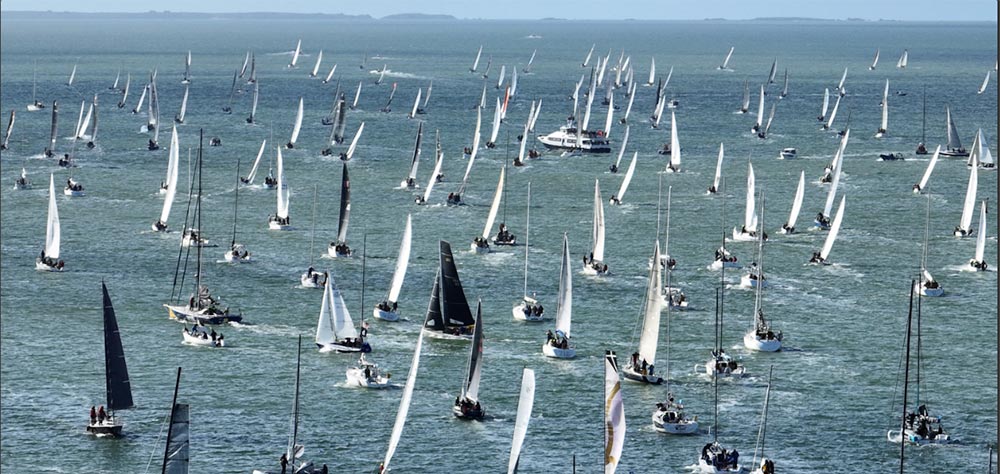
Photo by Thierre Creux courtesy of Spi Ouest France.
The rest of the race was equally hectic. At one point on the long upwind, a squall came in at 32 knots. We eased sails and hoped it was temporary, and soon enough it backed off to 18 to 25. On the final run to the finish, we were third in our class and gaining on second, as our bow-up configuration was finally paying off. During this time, the VHF was constantly chattering away in French, a language that is beautiful but mostly foreign to us. It was clear something was going on with the course or the finish. We nailed our jibe and were ripping into the finish, about to cap off a great week with a top score, probably second. But then there was a surreal moment as we closed on the line. There were actually two finish lines! Which one to pick? We ended up choosing the port one, as the other boats around us were finishing there. Later we found out we had finished incorrectly, and were scored DNF. So instead of being fourth overall we dropped to 11th. Same score as last year!
It was certainly disappointing to not get the score we felt we had earned, but on the other hand our other goals were well met during the week. Compared to last year, we were much better at starting and our tactics and communication were also more consistent. Our boat handling was very good, among the best in the fleet, except for our one spinnaker wrap. We got faster upwind as the week went on through a series of small improvements. So we actually felt really good about how we sailed and how much we learned. It is challenging to acknowledge that, and still account for what the results say, but sometimes you have to just accept that stuff happens in sailboat racing, even when you prepare well, and the scoreline is not the only measure of how you are really doing.
The next chapter for Red Ruby Racing is the most ambitious yet. Our boat partners Christina and Justin Wolfe are racing in the Cap Martinique Race, a 3,800 mile marathon from France to the Caribbean for solo and doublehanded boats. The routing shows between 18 and 24 days at sea! This will be absolutely epic and a true test of human and ship. Send good vibes to Chris and Justin, and follow along on Facebook at Red Ruby Racing. After Cap Martinique, the boat gets shipped back to France; and in July, Alyosha and I take on the next chapter, a series of three doublehanded races of 160 to 600 miles. Stay tuned as our quest for excellence in shorthanded ocean racing continues!
Thanks a lot to all of our fans and supporters! It is meaningful to know you are out there with us, sharing in our adventure. Thanks also to all the people that help us move Red Ruby around and keep her in top nick. We have developed a small group of trusted professionals around Europe and we couldn’t do it without you all. Of course we couldn’t go racing without competitors, and in the doublehanded world, the bonds are especially tight, and the respect is genuine.

